Austria
 From Rationalwiki
From Rationalwiki _-_AUT_-_UNOCHA.svg.png)
“”This is the main difference between Austria as the first invaded country and all the other countries that followed. You only need to compare the pictures of Prague some months later and Vienna. In Vienna you have this cheering crowd, and in Prague you had also all the people, but the people were crying, they had tears in their eyes. The majority of the Austrian population welcomed Hitler… In Austria antisemitism was even deeper rooted than in Germany. Vienna had a Jewish population of around 11%. And as soon as the German soldiers arrived in Vienna you had an outbreak of the worst anti-Semitic pogroms you ever had seen in central Europe since the Middle Ages.
|
| — Dr Winfried Garscha, historian with the Documentation Centre of Austrian Resistance in Vienna.[1] |
Austria (German: Österreich), officially the Republic of Austria (German: Republik Österreich) is a mountain and lake-filled country in Central Europe. It's notable for its rich Medieval and Early Modern history, being the home of the ultra-powerful Habsburg dynasty which ruled the Holy Roman Empire and championed Catholicism across Europe. On a much less happy note, Austria is also notable for its connections with Nazism, as Adolf Hitler was born in Austria and many Austrians enthusiastically participated in the Holocaust as well as the Congress of Vienna and the Reactionary response to maintain the despotic status quo of conservative monarchies and empowering them.[2]
Austria had humble beginnings as a minor frontier province of the Holy Roman Empire (HRE) in 996 CE, but it grew into an archduchy and came under the rule of the Habsburg dynasty. The Habsburgs then became rulers of the HRE as a whole and turned Austria into its administrative center. By marrying their way onto the thrones of Spain (and its empire), Czechia (then called Bohemia), and Hungary, the Austrian Habsburgs became the most powerful European dynasty in history. The Habsburgs and most of the Austrian people were avowedly Catholic, and they responded to the Protestant Reformation with mixed attempts at repression and conciliation. The religious conflict in Europe eventually exploded into the hideously bloody Thirty Years War between the Habsburgs and the combined powers of the Protestant states and Catholic France.
The Thirty Years War more-or-less destroyed the HRE as an entity, so Austria eventually went on to build its own empire, especially after being forcibly excluded from the unification of Germany. Austria compromised with its Hungarian subjects to become Austria-Hungary, which then started World War I after some guy from Serbia shot its Archduke. Austria performed quite poorly in that war and was dismembered in the peace deal. Humiliated and impoverished, Austria jumped at the chance to become part of the Third Reich after Hitler's forces marched in, in an event that would later become known as the "Anschluß", or "joining". After World War II, the Allies split Austria from Germany and put it under extended military occupation.
Since then, Austria has been an independent republic. It avoided partition or reparations since the Allies treated it as if it had been forcibly invaded by Germany. In order to avoid the Cold War problem of being nearly-surrounded by the Eastern Bloc, Austria remained firmly and declaredly neutral. Austria remains militarily non-aligned, but in 1995 it joined the European Union.
The rural part of Austria is full of mountains, snow, goats and the like. Carinthia (German: Kärnten) is full of lakes. Its capital Vienna (German: Wien) is full of people, music, culture, coffee houses and such things. The cutlet dish Wiener schnitzel (sometimes also spelled Wienerschnitzel) is also named after Vienna (it comes from the city's German demonym i.e. Viennese; German: Wiener). Americans later ripped off the pork version of the dish (it was originally made with veal) in the form of pork tenderloin. Austrians tend to speak Austrian German (Österreichisches Deutsch) which is a separate dialect but mutually intelligible to other German-speakers.[3]
About 60% of Austrians are Roman Catholic, 9% are Eastern Orthodox, 8% are Muslim, and a whopping 23% are unaffiliated.[4] The Muslim population is largely due to immigrants from Turkey and the Balkans.
History[edit]
_-_panoramio.jpg)
Humble beginnings[edit]
Austria first formed in 996 CE as a little march owned by the Babenburg dynasty.[5] At the time, it was a backwards frontier province established to defend against the Avar hordes, who were the predecessors of Hungary.[6] It was largely under the control of the HRE state of Bavaria. Not exactly the imperial power it would someday become.
In 1156, Holy Roman Emperor Frederick Barbarossa issued the Privilegium Minus to punish the Bavarians by splitting Austria into its own imperial territory.[7] Austria the little frontier march became a duchy, with the Babenburgs ruling as its hereditary dukes. Through a complex series of marriages, the Babenburgs expanded their small holdings into something that resembles the Austria of today. Arguably the most notable Babenburg was Duke Leopold V![]() , who participated in the Third Crusade. After a falling out with Richard the Lionheart
, who participated in the Third Crusade. After a falling out with Richard the Lionheart![]() following the siege of Acre
following the siege of Acre![]() , Leopold angrily quit the crusade and returned to Austria. Later, when Richard was trying to return to England, he was captured in Austria and imprisoned, thus delaying his return- and the massive ransom Leopold received for Richard's freedom was the basis of the Austrian mint and paid for Vienna's walls[8], while also contributing to economic problems in England that would feed into the Robin Hood
, Leopold angrily quit the crusade and returned to Austria. Later, when Richard was trying to return to England, he was captured in Austria and imprisoned, thus delaying his return- and the massive ransom Leopold received for Richard's freedom was the basis of the Austrian mint and paid for Vienna's walls[8], while also contributing to economic problems in England that would feed into the Robin Hood![]() myth.[9] Also, according to legend, Leopold's blood-soaked tabard- which showed a white stripe when he took off his belt- was the inspiration for the red-white-red flag that Austria still bears.[10]
myth.[9] Also, according to legend, Leopold's blood-soaked tabard- which showed a white stripe when he took off his belt- was the inspiration for the red-white-red flag that Austria still bears.[10]
The Babenburgs died out in 1246, allowing Austria to be passed to the small House of Habsburg (often anglicized as "Hapsburg"[11]), which was named after a castle in what's now northern Switzerland.[12]
Habsburg era[edit]
.jpg)
Conquest through marriage[edit]
About 150 years after gaining Austria, the Habsburgs started winning control of the Holy Roman crown, eventually establishing a near-monopoly on the imperial title. Since the Holy Roman Empire was a disunited collection of tiny squabbling states, the Habsburgs were one of the most powerful noble families in it due to their direct control of most of Austria, a factor which helped ensure their grasp on power.
The Habsburgs also expanded their holdings throughout the 1400s with a series of fortunate marriages. Through marriages with the dying lines of Burgundy and Spain, the Habsburgs inherited the Netherlands, a big chunk of France, and Spain (which came with the added bonus of a growing colonial empire).[13] Emperor Charles V, who took the imperial and Spanish crown in 1519, was the first man to be called the ruler of an "empire on which the sun never sets".[14] The empire was actually too big for one man to manage, so Charles V partitioned the Spanish holdings into its own Habsburg branch to be ruled separately but in an allied manner.
Looking for more conquests closer to home, the Austrian Habsburgs claimed the Czech throne in 1526 after the fortunate death of a relative.[13] Feudalism, making you cheer for the deaths of your brothers-in-law since the Middle Ages! The Habsburgs almost got all of Hungary too (then a substantially larger realm than it is today) but the Ottoman Empire gobbled up the eastern chunk before the Habsburgs could claim it all. This marked the beginning of the long, long, enmity between Turkey and Austria.
Fighting the Turks[edit]
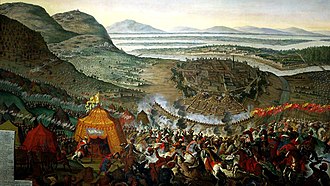
Austria, like basically the rest of Europe, wasn't exactly rich. To pay for defense against the massively powerful Ottoman Empire, the Habsburgs had to run around desperately borrowing money from rich merchant and banking families.[15] They also cracked down heavily on the part of Hungary that they owned, since Hungary was vital as both an economic asset and the frontier between Austria proper and the Turkish hordes.[16]
If it sounds like the Habsburgs were shitting themselves at this point, that's only because they totally were. Ottoman expansion had been rapid and brutal in the preceding decades, having taken out the remnants of the Roman Empire, then smashed all of allied Eastern Europe in the 1444 Crusade of Varna,[17] and then destroying the armies of Hungary at the 1526 Battle of Mohács (which is how Austria got the western half).[18] In 1529, the Turks reached the gates of Vienna itself with an army of over 100,000.[19] Luckily for the Habsburgs, the Turks got their heavy artillery stuck in mud, so they were unable to take Vienna. Even after that, the Hungarian question left the two powers at war until 1568, when the Ottomans decisively won out and consolidated their rule over eastern Hungary.[20] Not exactly a massive success for the Christians, but at least not a colossal defeat either. The wars moved on to the sea, where the Habsburg navies combined with the Spanish navies fought the Turks for control of trade. The Battle of Lepanto in 1571 between huge galley fleets marked the first major victory of the Christian powers over the Ottoman Empire, meaning that it had a huge impact on morale.[21]
Religious wars[edit]
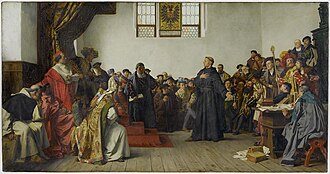
The Habsburgs were furiously opposed to the Protestant Reformation when it began in the 1520s thanks to the writings of Martin Luther in the German state of Saxony. When Pope Leo X excommunicated Luther, Emperor Charles V summoned Luther to the city of Worms in 1521 and demanded that Luther recant his writings. Luther famously refused, so the emperor issued the Edict of Worms stating:[22]
“”[W]e forbid anyone from this time forward to dare, either by words or by deeds, to receive, defend, sustain, or favour the said Martin Luther. On the contrary, we want him to be apprehended and punished as a notorious heretic, as he deserves, to be brought personally before us, or to be securely guarded until those who have captured him inform us, whereupon we will order the appropriate manner of proceeding against the said Luther. Those who will help in his capture will be rewarded generously for their good work.
|
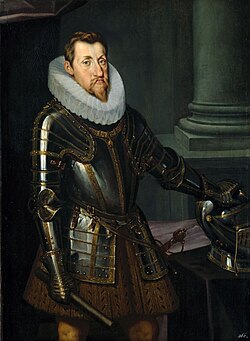
However, many other rulers within the Holy Roman Empire embraced Protestantism since it gave them an excuse to resist the emperor's authority. This led to an era of increasingly destructive religious conflicts. In the 1546 War of the Schmalkaldic League, the Protestants banded together in a defensive alliance to defend against an increasingly enraged emperor.[23] The emperor crushed them, but they rose up again in 1555 and won this time.[24] In the hopes of having everyone get the fuck along, the HRE's Imperial assembly passed the Peace of Augsburg, stating that German princes had the freedom to choose their state religion.[25] Unfortunately, it didn't recognize Calvinists as legitimate, and it ended up causing more war over the unprecedented phenomenon of Catholic prince-bishops converting to Protestantism but refusing to give up their land.[26]
Counter-Reformation[edit]
The Protestant movement also gained a large number of followers in Austria and the other Habsburg lands. The nobility tended towards Lutheranism, being the first branch of Protestantism and a nice reason to defy the emperor.[27] Authorities' attempts to censor Protestant pamphlets were repeatedly undermined by the Austrian nobility. The peasants, meanwhile, tended to prefer the Anabaptists due to their individualist teachings, but the nobility of all creeds considered the Anabaptists to be way too radical. Thus, between 1528 and around 1555, Anabaptists were burned at the stake in droves in a quest to crush heresy.[27]
As the Counter-Reformation got under way, the Habsburgs gradually became more zealous in purging their lands of Protestantism. This actually sparked a revolt in Hungary in 1593 as Protestant nobility ended up preferring the Ottomans over the Habsburgs, so oppressive had they gotten.[28] Young Habsburg prince Ferdinand II became responsible, with help from the Jesuits, for converting much of Austria back to Catholicism by force and with energetic proselytizing.[27] On the bad side, though, it gave Ferdinand II a very bad reputation with Protestants as a tyrant who would do everything to oppress them. This reputation wasn't unearned, as Ferdinand had expelled Protestants from his lands, censored publications, and had many people arrested.[29] Basically, Protestants everywhere hated his ass. If the HRE didn't want the religious powder keg to explode, then the last thing it would want to do was have Ferdinand II become emperor.
Thirty Years War[edit]
_(Peeter_Meulener)_-_Nationalmuseum_-_17230.tif.jpg)
Ferdinand II took the imperial throne in 1618 and immediately set about trying to expel Protestantism from other Habsburg lands. Protestants had overtaken much of the Bohemian Czech lands, so he sent his goons into its capital Prague to start shutting down Protestant churches.[30] This naturally resulted in resistance from the Czech population and nobles, and then resulted in an overall rebellion of Bohemia. The Czechs picked a Protestant as their new king and declared themselves independent, but the Habsburg armies from Austria won a major victory over them.[31] With Bohemia knocked out, Denmark came to the rescue in 1620 by intervening for a few years until they got knocked out too.[32] Then Sweden under its king Gustavus Adolphus entered the fray, actually managing to win some battles for a change.[33]
Meanwhile, Ferdinand II just kept making things worse by implementing more anti-Protestant decrees. Once in charge of Bohemia again, Ferdinand imposed a law saying that Protestants had six months to convert or else they'd have to flee into exile.[34] He also issued the Edict of Restitution, which legally confiscated all Protestant-held land in the entire Holy Roman Empire.[35] This colossally pissed off every Protestant ruler and completely undermined any chance Ferdinand II had of bringing the war to a quick conclusion. Hence the "thirty years". In 1631, his armies also committed the atrocity called the Sack of Magdeburg, in which Catholic forces butchered 20,000 Protestant inhabitants of the German city of Magdeburg.[36]
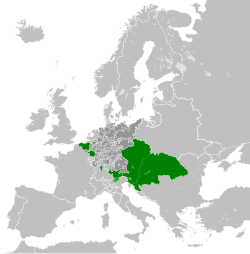
Despite the overwhelming destructiveness of the war elsewhere in Germany and Europe, Austria itself escaped most of the ill-effects since almost all of the fighting took place beyond its borders.[34] After much exhaustion and horrific slaughter, the war finally ended with an agreement of religious self-determination in the empire.[37] This more or less destroyed the Holy Roman Empire's central authority, and from that point forward, the Austrians would focus on their own holdings.
Religious consolidation[edit]
After the brutal Thirty Years War, rulers Ferdinand III and Leopold I focused on reestablishing the Catholic Church as the supreme religion within Austria. In large part, they were personally pious, but they also viewed the church as a useful tool of political control and found no contradiction between that and religious faith. In imposing religious conformity, they followed the model that Ferdinand II used in Bohemia. Closure of Protestant churches, expulsions, and Catholic appointments to vacated positions eliminated centers of Protestant power.[38] Some 40,000 people were forced out of Austria between 1647 and 1652.[38]
Habsburg oppression wasn't limited to Protestants. Leopold I especially hated Jews, and he expelled them from from their district in Vienna, which is now called Leopoldstadt.[39]
Habsburg decline, Austrian expansion[edit]
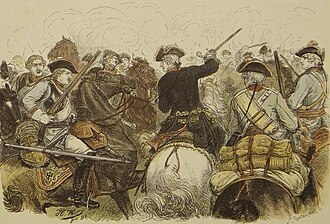
After the Thirty Years War, the Habsburg dynasty also started to slip into a period of decline. First the Spanish Habsburgs lost control of the Dutch lands during the Eighty Years War, begun in large part due to Catholic Spain's religious intolerance towards Dutch Protestants. Of course.
Austria, though, benefited from the slow decline of the Ottoman Empire. The second Ottoman attempt to take Vienna in 1683 resulted in a catastrophic defeat for the Turks thanks to the timely arrival of forces from Poland.[40] This was the turning point in 300 years of Ottoman-Habsburg enmity, and Austria managed to conquer eastern Hungary from the Turks and incorporate it into the growing Austrian state. Austria's economy and population also boomed during this time.
.JPG)
However well Austria did, it couldn't account for disasters elsewhere for the dynasty. The Spanish Habsburgs had for many decades engaged in the stupid and irresponsible policy of massive incest meant to keep titles within their family, with the end result that Spain's ruler Charles II had a family tree that looked more like a ladder.[41] Charles II was catastrophically inbred, and his jaw was so deformed that he could barely feed himself and couldn't speak.[42] He also couldn't walk or read. His wives were terrified of him, and the king never produced an heir before he died in 1700.[43] The really bad thing was that Charles II was the last Habsburg eligible for the Spanish throne.
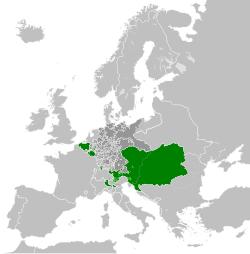
Cue the War of the Spanish Succession in 1701. Also known to snarky people as the "War of the Inbred Idiot", the War of the Spanish Succession lasted 12 years and resulted in the end of the Habsburg monarchy there as well as the crumbling of Habsburg holdings in Central Europe.[44] The French Bourbon dynasty took the Spanish throne (although the new king had to promise to never unite Spain with France), which was appropriate since Spain really needed a drink after all of that. In case you were wondering, this is why the current king of Spain, Felipe VI![]() , is from the House of Bourbon.
, is from the House of Bourbon.
Meanwhile, the Habsburgs failed to produce a male heir for the Austrian throne as well, leading to the Pragmatic Sanction of 1713 aimed at ensuring that Habsburg princess Maria Theresa could inherit the empire.[45] Maria Theresa's father, Charles VI![]() , convinced the other major European powers to agree to allow her to become empress (and even gave in to some steep demands to secure this agreement). Despite this, a few powerful German states which happened to hate the Habsburgs broke their promises and teamed up with France to contest this legal duct tape, thus beginning the War of the Austrian Succession upon Maria Theresa's accession to the throne in 1740.
, convinced the other major European powers to agree to allow her to become empress (and even gave in to some steep demands to secure this agreement). Despite this, a few powerful German states which happened to hate the Habsburgs broke their promises and teamed up with France to contest this legal duct tape, thus beginning the War of the Austrian Succession upon Maria Theresa's accession to the throne in 1740.
The powerful north German state of Prussia absconded with the rich Austrian province of Silesia after winning the Battle of Mollwitz,[46] while France and its new pal Spain beat up Austria and forced Maria Theresa to make her husband Holy Roman Emperor- which she did, although she continued to rule more or less as a "senior co-emperor" with him until his death in 1765, at which time their son succeeded them.[47] In the run up to the subsequent Seven Years' War![]() (or the "French and Indian War
(or the "French and Indian War![]() " for you Americans out there), which was essentially the "War of Austrian Succession Part II", Austria strangely dumped her old ally Britain and made friends with France, Spain, and Russia)
" for you Americans out there), which was essentially the "War of Austrian Succession Part II", Austria strangely dumped her old ally Britain and made friends with France, Spain, and Russia)![]() , and tried to reform and rebuild their military. The war itself started when Prussia basically guessed that Austria was about to attack them so they sneak attacked nearby Saxony, an ally of Austria; Austria then tried to reclaim Silesia, which they ultimately failed to do thanks to the efforts of Prussia's brilliant king and general, Frederick the Great
, and tried to reform and rebuild their military. The war itself started when Prussia basically guessed that Austria was about to attack them so they sneak attacked nearby Saxony, an ally of Austria; Austria then tried to reclaim Silesia, which they ultimately failed to do thanks to the efforts of Prussia's brilliant king and general, Frederick the Great![]() ; Silesia would remain part of Prussia until the dissolution of the German Empire in 1918 (it has been part of Poland since).
; Silesia would remain part of Prussia until the dissolution of the German Empire in 1918 (it has been part of Poland since).
On the plus side, Maria Theresa, her husband, and their son were modernist thinkers who embraced many aspects of the Enlightenment movement. In 1781, her son Joseph issued the Edict of Tolerance, which granted Protestants almost equal status with Catholics.[48] Austria also gained big swathes of Polish territory after that country's partition between Prussia and Russia.
Austrian Empire[edit]
.JPG)
Fucked by Napoleon[edit]
Austria opposed the French Revolution due to the fact that French queen Marie Antoinette was a Habsburg princess.[49] They really didn't like it when the Jacobin regime had her executed alongside her husband. Thus, Austria formed the backbone of the coalition against Revolutionary France. After some advances, though, the Austrians got their asses kicked by the French and had to cede large portions of their empire.[50]
When Napoleon took the French throne and declared himself emperor, the Habsburgs were furious since the Holy Roman Empire was supposed to be the only Catholic empire.[51] In the effort to help themselves feel special again, Habsburg ruler Francis II declared himself the Emperor of Austria and the Holy Roman Emperor, making him double emperor and ensuring that he was still technically Napoleon's superior. Napoleon never really gave a shit, though, since he knew that his real power came from the military rather than a title granted to himself.
In 1805, Austria tried to avenge itself upon Napoleon in the War of the Third Coalition, but much of the HRE's strength (meaning Prussia) stayed neutral, meaning that the Austrians and other powers didn't have much of a shot at victory.[52] This war saw Napoleon's great victory over Austria in the Battle of Austerlitz, one of Austria's worst defeats.[53] Austria capitulated, and the Peace of Pressburg effectively dissolved the Holy Roman Empire by taking most of its territory.[54] The Habsburgs now only had the one Austrian Empire.
Conservative dominance[edit]

After the reorganization of Europe following the defeat of Napoleon, Austrian statesman Klemens von Metternich (The Proto-Hitler, being an Austrian that was responsible for the era of repressive conservative rule) became the architect of a new European order enshrined around political conservatism in 1815.[55] In this he had the support of fellow absolute monarchies Prussia and Russia, which set aside their differences to jointly oppose liberalism and nationalism.
Austria also cut its expenditures way down to pay off debts, and it entered an era of political stagnation.[56] Under its emperor Franz Joseph, the Austrian government tried to go backwards by eliminating all representative institutions and forging closer political connections with the Catholic Church.[57] This policy of "neoabsolutism" was an unmitigated failure, as it pissed people off and increased resistance to Austrian power from minorities.
Fucked by nationalism[edit]
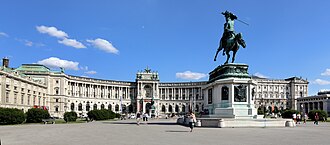
Austria couldn't hold back the tide of nationalist revolution forever, though. In 1859, its Italian provinces were seized by by the Kingdom of Piedmont-Sardinia with help from France, paving the way for the unification of Italy.[58] Austria's armies performed very poorly in the 1859 war, showing that it had become backwards and failed to compete in a modernizing world.[59] This contributed to a decline in Austrian power that made another nationalist movement possible.
Prussia, which had become an imperial power in northern Germany,[60] assumed the task of uniting the German states into an empire thanks to the goals of its Chancellor Otto Von Bismarck.[61] Austria actually opposed German unification, since joining a unified Germany would mean that it would almost certainly have to sacrifice its holdings elsewhere that were filled with non-German ethnicities.[62] In other words, they counted the birds in the hand rather than the birds in the bush. In retaliation for their uncooperativeness, Bismarck diplomatically isolated Austria in the lead-up to an inevitable war between Austria and Prussia over the fate of Germany.[63]
The Austro-Prussian War of 1866 resulted in a rapid victory for the industrialized Prussian state over the backwards conservative Austria.[64] Prussia united northern Germany under its rule, and a few years later fought a war with France to create the German Empire in 1871. Austria's era of being the primary power in Germany was over.
Austria-Hungary[edit]
.svg.png)
Dual monarchy[edit]
Nationalism also became popular among Austria's Hungarian subjects. It became apparent that if Austria was to survive in a modern world, it would need the cooperation of its Hungarian subjects. Its Hungarian subjects would not give that cooperation without a little bit of give. In 1867, this resulted in the Ausgleich. It divided the Austrian Empire into two states, Austria and Hungary, which would have equal rights but share the same ruler.[65] This arrangement became known as the "Dual Monarchy", and the Austrian Empire became the Austro-Hungarian Empire. This new "state" didn't even have a national flag, and instead used a series of civil ensigns which had no official status.[66]
Austria and Hungary had two separate legislatures in their capitals, but the emperor had extensive powers in the conduct of foreign and military affairs. Other nationalities, especially the Slavs, were excluded from this arrangement and just had to stew in resentment. Hungary also had the ability to arm-twist Austria, since the customs union and accounts sharing parts of the deal were renegotiated every ten years.[67] All in all, it wasn't the most stable foundation for a modern state.
Reconciliation with Germany[edit]
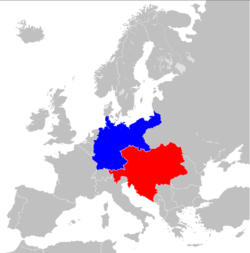
After the formation of the German Empire, the Austrian monarchy finally conceded the fact that Germany was truly lost to it. Instead of stupidly maintaining hostility against Germany, the Austrians cozied up to them instead based upon mutual distrust of Russia. The Germans were enthusiastic to ally with Austria-Hungary, as they too were in the market for a new pal, and the two empires lived happily ever after worked together against their common enemies while the Germans intentionally alienated German nationalists in Austria.[68]
Austria then turned east for its future expansion, an avenue opened by the Ottoman Empire becoming the "sick man of Europe". Russia forced Turkey to release almost all of its European holdings, liberating Bulgaria and Bosnia, reunifying Serbia, and allowing Romania to form.[69] With Germany holding Russia at bay, Austria moved in to occupy Bosnia and turn it into an effective subject state of the empire.[68]
There were some ultimately negative consequences for Austria, though. In 1882, Austria got sucked into signing the Triple Alliance with Germany and Italy. The problem was that Italy had territorial claims against Austria based on irredentism, and the pact did nothing at all to resolve those tensions.[68] Germany hi-fived its two allies, but Austria and Italy just glared at each other.
Serbia was also pissed at Austria since it had occupied Bosnia, which had a large Serbian population. In 1906, Austria pissed off Serbia and its sponsor Russia by formally annexing Bosnia, which hadn't been in the previous arrangements.[70] With German backing, though, Austria threatened Russia into standing down.[71] It was a costly victory. For the little province of Bosnia, Austria had pissed off the Russian bear. And for some mountainous chunks of Italy, Austria had also undermined Italy's alliance with Germany.
Uh oh.
World War I[edit]
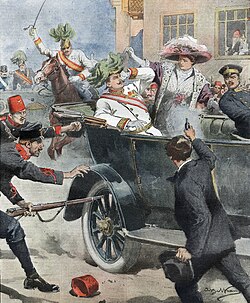
Austria's archduke and heir to the throne, Franz Ferdinand, went on an exciting trip to the Bosnian city of Sarajevo in 1914 to review Austrian troop exercises there.[72] Then a Serbian nationalist named Gavrilo Princip capped his ass along with his wife after a failed attempt at bombing him.[73]
Ferdinand's death made surprisingly little impact in Austria; as one historian remarked, "The event almost failed to make any impression whatsoever. On Sunday and Monday (the day of and the day after), the crowds in Vienna listened to music and drank wine, as if nothing had happened."[74] In Sarajevo, however, the Austrian government encouraged an anti-Serb pogrom that caused two deaths and the destruction of much property.[75] The Austrian government quickly determined that a Serbian citizen was responsible, and they resolved to go to war with Serbia after getting agreement from Germany.[76] Austria sent Serbia an ultimatum, expecting Serbia to decline, and then triumphantly turned down Serbia's compromise solution.[77] The Germans, meanwhile, set about trying to convince France and the UK to stay out of it. Their diplomats used intentionally soft language to describe Germany's plans, fooling the French and British into thinking that the Germans also hoped to keep the peace in the Balkans.[77]

Germany immediately supported Austria when they declared war on Serbia. Germany had never intended to stop the war; it only hoped to sow enough doubt to stop the other great powers from intervening. The German ambassador to Russia recounted that the Russian Foreign Minister "now saw through our whole deceitful policy, he no longer doubted that we had known the Austro-Hungarian plans and that it was all a well-laid scheme between us and the Vienna Cabinet."[78] This deceit enraged Russia and France enough to make them join the war anyways.
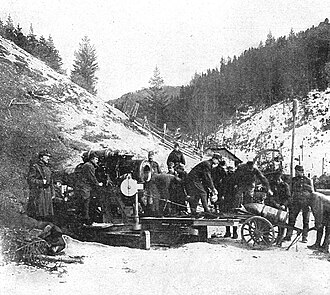
Austria performed remarkably badly during WWI. Its multi-ethnic military had trouble communicating, and the two national militaries had trouble coordinating with each other.[79] The result was a pile of bad leadership that hamstrung Austria in the war. Austria was so bad that it failed to crush Serbia, a much smaller country with a much smaller army.[80] Austria then had its military crushed by Russian forces, and it tried an ill-fated attempt in 1915 to attack Russia in the winter.[81] Like we said, bad leadership. The campaign was ruinous for Austria, with hundreds of thousands of soldiers perishing pointlessly. However, in the chaos following the Bolshevik revolution of 1917, Austria and Germany were able to gobble up huge swathes of largely helpless Russia; this conquest was codified in the Treaty of Brest-Litovsk![]() .
.
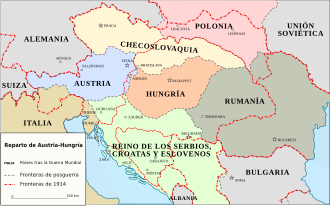
In other bad news for Austria, Italy refused to join the war despite being allied with Austria and Germany- remember that foreshadowing earlier about how the Triple Alliance didn't address Italian irredentism? That was still a thing, and Italy also had no interest in helping Austria conquer Serbia. So Italy's leaders claimed that the alliance was purely defensive and since Austria was the aggressor, Italy was under no obligation to join the war.[82] To make matters worse, after secret negotiations with the British, Italy switched sides and joined the Entente in 1915. Italy tried to invade Austria through the Alps north of Venice- but Italy's army was in even worse shape than Austria's, with even worse generals![]() - which is really saying something. Although Italy technically "won" the majority of the battles on the Italian front, they did so with a tremendous loss of human life for very little gain. The war ended for Austria after the battle of Vittorio Veneto
- which is really saying something. Although Italy technically "won" the majority of the battles on the Italian front, they did so with a tremendous loss of human life for very little gain. The war ended for Austria after the battle of Vittorio Veneto![]() at the end of October 1918, when Italy, with help from Britain, France, and even a token force from the US, completely destroyed or captured what remained of the Austrian army.
at the end of October 1918, when Italy, with help from Britain, France, and even a token force from the US, completely destroyed or captured what remained of the Austrian army.
When it became clear to everyone that Austria was going to lose at Vittorio Veneto and with the Imperial government completely incapable of stopping them, parts of the empire began declaring independence![]() , notably Czechia on October 28th, Yugoslavia on October 29th, Slovakia on October 30th, and Hungary on October 31st. By the time Austria signed an armistice
, notably Czechia on October 28th, Yugoslavia on October 29th, Slovakia on October 30th, and Hungary on October 31st. By the time Austria signed an armistice![]() in early November 1918, the empire was already dissolved. Eight days later, Emperor Charles "abdicated"[83]; that same day, with her main ally completely destroyed and a revolution
in early November 1918, the empire was already dissolved. Eight days later, Emperor Charles "abdicated"[83]; that same day, with her main ally completely destroyed and a revolution![]() breaking out at home, Germany surrendered, thus finally ending the war. In the 1919 Treaty of Saint-Germain, Austria was forced to acknowledge Czechoslovakia and Hungary as independent states, cede Galicia to Poland, and cede various territories to Italy and the newly formed Yugoslavia.[84] The Entente had stupidly promised competing territorial claims for both Italy and Yugoslavia, and Italy's fury at failing to get everything they wanted led to its political collapse and subsequent rise of Benito Mussolini.[85]
breaking out at home, Germany surrendered, thus finally ending the war. In the 1919 Treaty of Saint-Germain, Austria was forced to acknowledge Czechoslovakia and Hungary as independent states, cede Galicia to Poland, and cede various territories to Italy and the newly formed Yugoslavia.[84] The Entente had stupidly promised competing territorial claims for both Italy and Yugoslavia, and Italy's fury at failing to get everything they wanted led to its political collapse and subsequent rise of Benito Mussolini.[85]
Instability in the First Republic[edit]
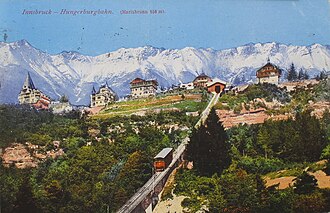
After the abdication of Karl I, Austria ended centuries of Habsburg rule and reformed into a republic for the first time. At the time, Austria's very existence was unusual. Unlike Hungary or Germany, Austria had never had any claim to nationhood, simply having been a holding of the Habsburgs within Germany.[86] The challenge of forming a national identity would overshadow this rump state's early politics.
Austria generally had three political factions during this time, the Nationalists, the Social Democratic Workers' Party (Sozialdemokratische Arbeiterpartei—SDAP), and the Christian Social Party (Christlichsoziale Partei—CSP).[87] You'll notice that the nationalists weren't represented by a single party. This was because they were extremely divided, mostly over the issue of whether to unite with Germany or forge an independent path. On the fringes of the nationalist camp also emerged the Nazi Party, a branch of the same movement popularized by the Austrian-born Adolf Hitler in Germany.
The 1919 elections saw the SDAP gain a convincing plurality, and they formed a coalition with the CSP to write a democratic constitution. They had a tough road to govern. Austria's traditional sources of food and coal were now long gone within other states, and the Entente powers punished them as the successor to the Austro-Hungarian Empire. Political divisions and unstable elections perpetually undermined the republic's ability to cope with these crises.[88]
In 1932, Engelbert Dollfuss of the CSP won a narrow margin for his party in the legislature. While the Nazis demanded a new election, Dollfuss instead started to crack down on political opposition while diplomatically allying with fascist Italy.[89] In 1933, he used an emergency powers act to seize control of the Austrian government, ban the extreme left an right parties, and make himself dictator.
Fatherland Front dictatorship[edit]

To prop himself up as dictator, Engelbert Dollfuss established the Fatherland Front (Vaterländische Front, VF) to serve as his own authoritarian political faction. It was kinda but also kinda not fascist. Rather than promote any kind of revolutionary or mass political action, the VF was instead ultra-conservative in hearkening back to the good old days of Metternich-style religious moralism.[89] Dolfuss was also fanatically anti-Nazi. He opposed the idea of joining Germany, instead hoping to see Austria resume its historical role as the Central European Catholic bulwark. In this, he had the support of Italian dictator Mussolini, who also thought little of Hitler and his racism.[90]
Despite establishing a dictatorship, Dollfuss was unable to heal the political divides in Austrian society. The nationalists simply plotted with Germany to see him overthrown, and the socialists screamed for revolution against him. In 1934, the brief Austrian Civil War broke out when the socialists seized control of several major cities before being violently crushed by state forces.[91]
Dollfuss tightened the screws, but that wasn't the end of Austria's political violence. Another uprising came later in 1934, this time from the far-right. Austrian Nazi loyalists attempted a coup against the Fatherland Front regime, and the leader of the Nazi Party personally strode into Dollfuss' office and shot him.[92] Hitler tried to send troops into Austria, but he was stopped by a military mobilization from, of all people, Mussolini.[93]
Dollfuss was succeeded as chancellor by Kurt von Schuschnigg, and Schuschnigg filled his government with loyalists who were actually taking their orders from Hitler.[94] Mussolini also warmed up to Hitler thanks to their shared scorn for the League of Nations response to the Italian war in Ethiopia. By 1938, there was nothing at all stopping Hitler from taking Austria, so that's exactly what he did.
Third Reich[edit]
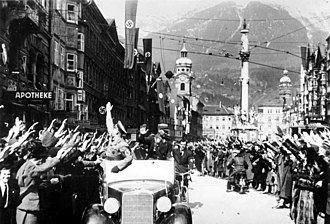
Hitler received such an enthusiastically positive response to his annexation of Austria that he decided to absorb it completely rather than attempt to preserve its national identity. The annexation had an immediately horrific impact on Austria's Jews. Austrian and German Nazis unleashed a wave of violence upon the country's Jews, smashing Jewish homes and shops, beating the crap out of Jewish people, and forcing other Jews to participate in humiliating performances of cleaning streets or toilets.[95] Anti-Jewish legislation like the Nuremberg Laws also went into place immediately, and Jews were subject to increasingly intense persecution. Tens of thousands of Jews fled Austria, and they were subjected to the huge "flight tax", which the government charged them for the privilege of getting to leave.
The wave of celebratory violence also helped the Nazi regime consolidate its hold over Austria. Any Austrian politicians or citizens who opposed the German annexation were quickly arrested and tortured into either compliance or death.[96] To house these "traitors to the people", the Nazi regime built the Mauthausen concentration camp shortly after the Anschluss to serve as its primary punishment facility in Austria.[97] 1938 also saw the Kristallnacht pogroms sweep across Germany and Austria, and if anything the violence in Austria was actually even worse than in Germany.[98]

Mauthausen saw a huge increase in its population after Nazi Germany started World War II. Republican refugees from the Spanish Civil War brought in from France, religious conscientious objectors, and of course Jews ended up there too to join the many Austrian political prisoners.[97] It became one of the primary implementation sites for the Nazi strategy of "extermination through labor" as a means of committing the Holocaust, and its prisoners built airplanes and carried heavy loads up and down the "Stairs of Death".[99] The camp had a death toll of between 122,766 and 320,000.[100]
During the world war, some 800,000 Austrians were drafted into the German military and another 150,000 served in the Waffen-SS.[101] Since Austria was out of reach of Allied bombers, its population generally supported the war effort throughout the years.
In the 1943 Moscow Declaration, the Allies called Austria the "first free country to fall a victim to Hitlerite aggression" and called for its renewed independence.[102] However, the declaration also stated that Austria would be held accountable for those of its population who served the Nazis and that the Allies considered Austria to be an enemy. The last year of the war, 1945, saw forces of both the Soviet Union and the Western Allies invade Austrian soil. One of the last engagements of the European war took place on Austrian soil, the Battle for Castle Itter, in which the United States and defected German troops helped liberate French prisoners of war.[103]
Allied occupation[edit]

After bombing Vienna to shit, the Soviets quickly occupied the city, reasoning that it would be a nice bargaining chip against the Western Allies over the fate of Europe.[104] The Soviets put crusty old First Republic socialist Karl Renner in charge, reasoning that the old man would be easy to manipulate. Instead, Renner took that authority and used it to establish a democratic provisional government based on the principle that Austria was once again free and that Austria would once again be a representative republic.[105]
Austria itself was divided between various Allied occupation zones much like Germany. One notable difference, though, was that all of the Allies eventually recognized Renner's provisional government as legitimate. Also like Berlin, Vienna was divided. At that point, the plans ran out, since the Allies had never gotten past the 1943 Moscow Declaration stating that Austria was to be split from Germany and presumably treated a bit nicer.
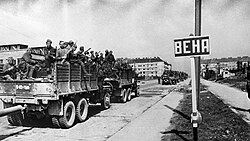
In 1945, Austria held its first elections. The Nazi Party was banned (good) and three parties formed to dominate Austria's politics. The Austrian People's Party (Österreichische Volkspartei, ÖVP) represented conservative interests, while the Social Democratic Party of Austria (Sozialdemokratische Partei Österreichs, SPÖ were social democrats, and a small Soviet-backed Communist Party of Austria (Kommunistische Partei Österreichs, KPÖ) represented communist interests. The elections saw a major victory for the ÖVP while the KPÖ ate shit and ended up with barely any vote or representation.[106] That pissed off the Soviets quite a lot, while the Allies were happy. It got even better when the intended Soviet puppet Karl Renner was named president by the conservative-dominated Parliament. All in all, it seemed like a good result, but you also have to consider that all of the old Nazi supporters were basically disenfranchised. So not out of the woods just yet.
In light of this democratic success story, the Western Allies pushed for a 1946 Control Agreement which gave the Austrian government more authority to manage its own affairs. Once again, this ended up being at the expense of the Soviets, who had wanted to seize Austria's oil assets and ended up being vetoed by the Austrian government.[106] Having realized this too, the Austrian government cheerfully started to pass laws while ignoring Soviet objections.
Meanwhile, the government had to figure out how to deal with ex-Nazis while still maintaining the premise that Austria was a victimized nation. They required ex-Nazis to register their status, and some 536,000 did so.[107] Realizing that this was actually a huge proportion of the Austrian population (almost 8%), the government then drew a distinction between "more implicated" party leaders and officers, and "less implicated" low-level party members. In 1947, Austria granted amnesty to the latter group.
Austria was also saved from the typical Soviet takeover by the left-wing reasonableness of Karl Renner, as both democratic parties rallied around him in order to exclude the Soviet-style communist party from governance.[108] Thus, over Soviet objections, Austria applied for and received Marshall Plan aid from the United States to help rebuild its shattered economy.
Second Republic[edit]
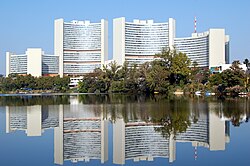
Austria managed to receive a treaty of independence in 1955 by promising not to join any military blocs, promising to safeguard minority rights, and promising to never again try to unify with Germany or establish a monarchy.[109] Acceptance of this plan was helped along by the fact that the paranoid Joseph Stalin had died. It also helped that East Germany and West Germany were coming into play in the Cold War and nobody wanted to risk upsetting the stalemate too much by throwing Austria into the mix.
Since then, Austria has been a fairly tranquil little republic, usually governed by a grand coalition of the ÖVP and SPÖ. A few things disturbed that tranquility. One, Austria has always struggled to deal with the legacy of its culpability in the Nazi crimes.[110] It then caused international outrage by electing former Nazi intelligence officer Kurt Waldheim as its president in 1986.[111] Oh dear. While it was previously known that Waldheim had been a Nazi, the full extent of his actions during the war, including war crimes, had not been publicly known until 1987 when the US government compiled a 232-page report, a summary of which was made public at that time.[111]
On the plus side, Austria joined the European Union in 1995 and seems to benefit from that joining.[112] Austria since 1980 has also been the host of the United Nations Office at Vienna, one of the four major UN headquarters in the world.[113]
Politics[edit]
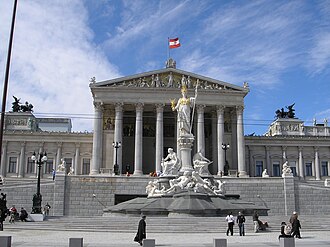
In the world of European politics, Austria is kind of like that drunken, conservative uncle you dread having to deal with at the holidays. The country is overall fairly conservative, owing in no small part due to the dominance of Catholicism, but has a widening undercurrent of far-right extremism, with one particular far-right party becoming increasingly popular over time. Thanks to post-WW2 immigration from the Middle East that has spiked in the last twenty years or so (we're not sure what exactly is causing it...), there is also a strong undercurrent of anti-immigrant, especially anti-Muslim, sentiment and even political parties that have historically not been anti-immigrant are becoming so.[114][115] During election seasons, anti-immigrant slogans like "Wien darf nicht Istanbul werden" ("Vienna must not become Istanbul") are commonly used by the anti-immigrant crowd.
Like most European countries, the government is set up in a parliamentary system, with a President as the figurehead head of state; and a Chancellor, who is elected by the party or coalition controlling the majority of seats in the Nationalrat ("National Council") as head of government.[116] While there are many political parties[117], there are five main parties that largely run the country's politics:
- The Österreichische Volkspartei ("Austrian People's Party
 ") or ÖVP - a fairly typical Christian conservative party.
") or ÖVP - a fairly typical Christian conservative party. - The Sozialdemokratische Partei Österreichs ("Social-Democratic Party of Austria
 ") or SPÖ - a fairly typical social democratic party.
") or SPÖ - a fairly typical social democratic party. - The Freiheitliche Partei Österreichs ("Freedom Party of Austria
 ") or FPÖ - a fairly typical far-right party
") or FPÖ - a fairly typical far-right party - Die Grünen - die Grünen Alternativ ("The Greens – The Green Alternative
 ") or simply "die Grünen" ("The Greens") - a fairly typical center-left Green Party.
") or simply "die Grünen" ("The Greens") - a fairly typical center-left Green Party. - The NEOS ("Das neue Österreich und Liberales Forum" or "The New Austria and Liberals Forum
 "), a fairly typical liberal party.
"), a fairly typical liberal party.
Freedom Party of Austria[edit]
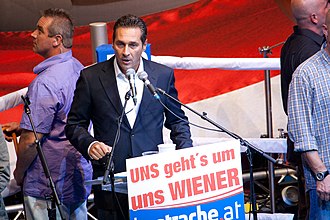
Since Austria's re-independence in the aftermath of World War II, the ÖVP and SPÖ have generally been the parties in power, frequently in coalitions with each other.[118] The FPÖ originated in the 1950s as an anti-establishment centrist liberal party, initially led by ex-Nazis.[119] It failed to really gain any traction, but that all changed in the 1980s, when a Hitler-wannabe named Jörg Haider took control of the FPÖ in the state of Carinthia, and then at the national level, and shifted it to the right with his own particular blend of populist anti-immigration and anti-establishment (especially euroskeptic) rhetoric that made him surprisingly popular among conservatives and even some disillusioned social democrats[120]- he was basically Trump before Trump was Trump. He became famous on the world stage for making remarks that seemed to be overly nice towards Hitler and the Nazis[121], and when he formed a coalition with the ÖVP in the early 2000s, many countries refused to work with the new government, which forced Haider to resign from said government.[122]
After Haider's resignation in 2000, friction within the FPÖ caused it to lose dramatically at the 2002 elections[123], but it remained in a coalition with the ÖVP until 2006, when the SPÖ surprisingly won enough seats to overtake the ÖVP; the SPÖ then formed a coalition with the ÖVP that would last until 2017.[124] An internal revolt![]() by Haider loyalists within the FPÖ ultimately led to Haider and his sister to break away in 2005 and form a splinter party, the BZÖ (Bündnis zur Zukunft Österreichs or "Alliance for the Future of Austria
by Haider loyalists within the FPÖ ultimately led to Haider and his sister to break away in 2005 and form a splinter party, the BZÖ (Bündnis zur Zukunft Österreichs or "Alliance for the Future of Austria![]() "); Heinz-Christian "HC" Strache
"); Heinz-Christian "HC" Strache![]() replaced Haider as the leader of the FPÖ.[125] By 2008, both parties were gaining traction and in elections that year, combined for over 25% of the vote.[126] However, Haider died in a car crash shortly after the 2008 elections[127], and without his leadership the BZÖ, while still technically existing to this day, has dramatically lost influence and is virtually irrelevant, while the FPÖ has regained and surpassed its pre-schism power.
replaced Haider as the leader of the FPÖ.[125] By 2008, both parties were gaining traction and in elections that year, combined for over 25% of the vote.[126] However, Haider died in a car crash shortly after the 2008 elections[127], and without his leadership the BZÖ, while still technically existing to this day, has dramatically lost influence and is virtually irrelevant, while the FPÖ has regained and surpassed its pre-schism power.
In 2016's presidential elections, the FPÖ candidate Norbert Hofer![]() shockingly defeated five other candidates in the first round of voting with 35.1% of the vote.[128][129] In the mandatory runoff election, Hofer initially won but after absentee votes were counted, he just barely lost to the Greens candidate Alexander van der Bellen
shockingly defeated five other candidates in the first round of voting with 35.1% of the vote.[128][129] In the mandatory runoff election, Hofer initially won but after absentee votes were counted, he just barely lost to the Greens candidate Alexander van der Bellen![]() , 50.3% to 49.7%. However, the results were challenged in the courts; the Constitutional Court annulled the results of the runoff and ordered it to be redone.[130] Van der Bellen ultimately won the election; but because the majority SPÖ fared poorly in the election, the chancellor resigned[131], triggering parliamentary elections to be held in 2017. In the 2017 elections, the FPÖ gained enough seats in the Nationalrat to form a coalition with the ÖVP under Sebastian Kurz
, 50.3% to 49.7%. However, the results were challenged in the courts; the Constitutional Court annulled the results of the runoff and ordered it to be redone.[130] Van der Bellen ultimately won the election; but because the majority SPÖ fared poorly in the election, the chancellor resigned[131], triggering parliamentary elections to be held in 2017. In the 2017 elections, the FPÖ gained enough seats in the Nationalrat to form a coalition with the ÖVP under Sebastian Kurz![]() (who was age 31 at the time, making him Europe's youngest head of government), and HC Strache became the Vice-Chancellor.[132]
(who was age 31 at the time, making him Europe's youngest head of government), and HC Strache became the Vice-Chancellor.[132]
Under Strache's leadership, the FPÖ drifted even further to the right, especially on immigration.[133] He formed ties with the Trump[134] and Putin administrations, cut a deal to work with Putin's United Russia party[135], and has endorsed far right conspiracy nonsense like The Great Replacement.[136] Remember earlier, that political slogan about Vienna not becoming Istanbul? No joke, that was one of his.[137] However, in 2019 during a visit to Ibiza, Strache and one of his top deputies were caught in a sting where they were filmed candidly talking about how they were willing to accept bribes from Russian oligarchs.[138] The international furor over the Ibiza affair![]() caused the coalition to immediately collapse, Strache resigned in disgrace (Hofer replaced him as FPÖ chair), and a successful vote of no confidence removed Kurz from office, triggering a new round of parliamentary elections.[139]
caused the coalition to immediately collapse, Strache resigned in disgrace (Hofer replaced him as FPÖ chair), and a successful vote of no confidence removed Kurz from office, triggering a new round of parliamentary elections.[139]
Despite the Ibiza affair, in the 2019 elections Kurz and the ÖVP held on as the largest party in the Nationalrat. The center-left Greens took advantage of the severe blow to the FPÖ[140], and won enough seats that they were invited to form an unlikely coalition with the conservative ÖVP. The ÖVP-Greens coalition rules Austria to this day.[141] However, in early October 2021, after months of rumors of an investigation into Kurz[142], agents from Austria's federal anti-corruption agency raided multiple locations including the Chancellor's Office, the Ministry of Finance, and the ÖVP headquarters as part of an investigation into allegations that the ÖVP had misused government funds to pay for positive media coverage during Kurz's rise to power in 2016.[143] To avoid the ÖVP-Greens coalition falling apart, Kurz agreed to a deal wherein he resigned as chancellor (but not as chairman of the ÖVP, allowing him to retain significant influence) on October 10th; the next day Alexander Schallenberg![]() was appointed the new chancellor.[144] At the beginning of December 2021, amid controversy and protests against COVID-19 lockdowns and vaccine mandates[145], Kurz fully resigned from politics[146], and Schallenberg resigned as chancellor[147]; the new Chancellor is acting ÖVP chairman Karl Nehammer
was appointed the new chancellor.[144] At the beginning of December 2021, amid controversy and protests against COVID-19 lockdowns and vaccine mandates[145], Kurz fully resigned from politics[146], and Schallenberg resigned as chancellor[147]; the new Chancellor is acting ÖVP chairman Karl Nehammer![]() .[148]
.[148]
States of Austria[edit]
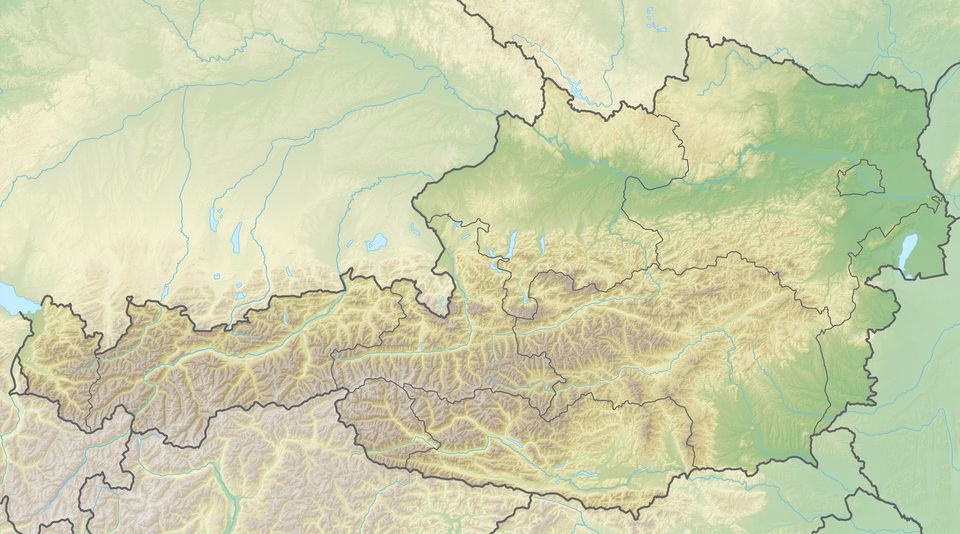
born here
Tyrol
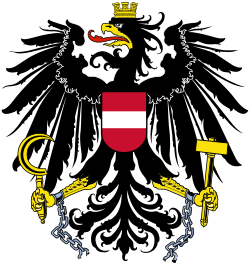
The states in Austria are called Bundesländer (German, lit.: "federal countries"), just like in Germany.
| Arms | State (German name) | Capital |
|---|---|---|
 |
Eisenstadt | |
 |
Klagenfurt | |
 |
St. Pölten | |
 |
Salzburg | |
 |
Graz | |
 |
Innsbruck | |
 |
Linz | |
| Vienna | ||
 |
Bregenz |
Crown Jewels[edit]
As a European superpower, it's no surprise that Austrian rulers went to great lengths to amass a huge collection of royal items to show off their wealth and power. Some of the items, however, have a fairly unique nature compared to the collections of other nations. The Imperial Regalia, for instance, dates back to the Holy Roman Empire. The Reichskrone was commissioned for the coronation of Otto I as the first Holy Roman Emperor in 962 CE, and it's so old that its jewels were never faceted because that technique was still unknown.[150] However, the real highlight of that collection is the Holy Lance, a relic traditionally believed to have been used to pierce the side of Jesus during the crucifixion. Its authenticity is dubious, though, since there are at least three existing claimants to the title of the true "Holy Lance".[151] Less famous is the Imperial Cross, which once held a fragment of the True Cross, which is also preserved next to it.
Other items in the collection include the crown of the Austrian Empire, the 36-carat Wittelsbach Diamond (valued at $16 million),[152] and the Cradle of the King of Rome, which once held the son of Napoleon Bonaparte.[153] There's also an item once thought to have been a unicorn horn that was used for what was believed to be medicinal properties. Nowadays, people realize that the horn far more likely came from a narwhal.[154]
The artifacts are all preserved in the Imperial Treasury in the Hofburg Palace, open to be viewed by the public.[155]
2.jpg)
The Reichskrone
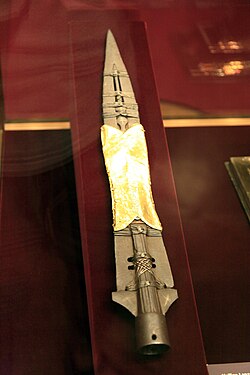
The alleged Holy Lance.
Alleged fragment of the True Cross.
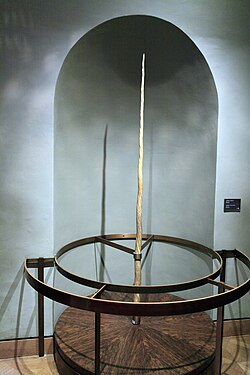
The "unicorn" horn.
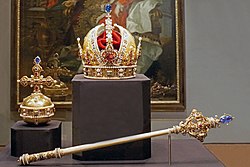
Crown, orb, and scepter of the Austrian Empire.
Fucking[edit]

Fucking was a village in Upper Austria until the fucking villagers renamed it to Fugging in 2021,[156] perhaps as an homage to The Naked and the Dead![]() or The Fugs.
or The Fugs.![]() It was pronounced "FOO-king." This is because of intense petitioning from its Scottish residents. Or rather because of German pronunciation rules. There were originally two fucking Fuckings in Austria ("As above, so below"[157]) until 1836 when the Fucking in Lower Austria fucking changed its name to Fugging.[158] Oh hello, Norman Mailer![159]
It was pronounced "FOO-king." This is because of intense petitioning from its Scottish residents. Or rather because of German pronunciation rules. There were originally two fucking Fuckings in Austria ("As above, so below"[157]) until 1836 when the Fucking in Lower Austria fucking changed its name to Fugging.[158] Oh hello, Norman Mailer![159]
What did you think you would find when you typed "fucking" into the search box? And they want to make a light beer in the village, and in German, light beer is called 'hell'. Make of that what you will.
Famous and infamous people from Austria (not necessarily from Fucking, Austria)[edit]
- Hans Asperger, namesake of the syndrome that has become known as "autism lite."
- Felix Baumgartner

- Ludwig Boltzmann, statistical physicist and early pioneer of the atomic hypothesis
- Franz Ferdinand, heir of Austrian-Hungary and assassinated in Sarajevo, Bosnia, by Serbian terrorists which led to Austria-Hungary declaring war on Serbia
- Adolf Hitler, failed artist and Führer of Nazi Germany
- Sigmund Freud, a psychoanalyst
- Dietrich Mateschitz
 , the richest Austrian in existence, CEO of Red Bull
, the richest Austrian in existence, CEO of Red Bull and enabler of Alt-right shithead Martin Sellner
and enabler of Alt-right shithead Martin Sellner - Wolfgang Amadeus Mozart (born and raised in Salzburg, which at the time wasn't part of Austria, but spent most of his adult life in Vienna.)
- Wolfgang Pauli, quantum physicist best known for the Pauli exclusion principle
- Karl Popper, an influential philospher of science
- Arnold Schwarzenegger, an actor and politician, former governor of the State of California
- Erwin Schrödinger, quantum physicist of Schrödinger's equations fame, and possible cat owner.
- Ludwig von Mises, a remarkably untalented economist
- Leopold von Sacher-Masoch, author of Venus in Furs, utopian, feminist and, as his name implies, trope namer for masochism. The Sacher-Masoch-Torte with red currants and almonds was named after him.[160]
- Maria von Trapp
- Kurt Waldheim
 , politician and diplomat who served as secretary-general of the United Nations in the 1970s; in the mid-1980s it came out that he probably participated in the Holocaust. Oops.
, politician and diplomat who served as secretary-general of the United Nations in the 1970s; in the mid-1980s it came out that he probably participated in the Holocaust. Oops. - Arnold Schoenberg

- Josef Fritzl
 , a monster of a human, famous for building a dungeon in his basement, locking his own daughter in it for 24 years, and raising a family with her.
, a monster of a human, famous for building a dungeon in his basement, locking his own daughter in it for 24 years, and raising a family with her.
Gallery[edit]
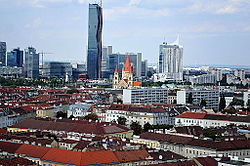
Vienna International Centre.
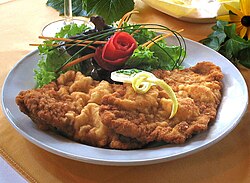
Wiener Schnitzel.
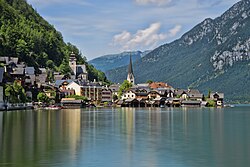
Hallstatt in Upper Austria.
Children in the Austrian hills.
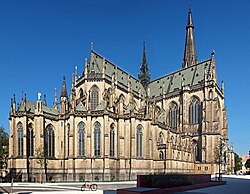
Cathedral of the Immaculate Conception in Linz.
An Austrian Leopard 2A4 tank.
See also[edit]
- Austrian school
- Vienna Circle
- Thirty Years War
External links[edit]
- Why did Austria / Austria-Hungary decline? a short video by History Matters on Youtube. Also,
- Why is South Tyrol a part of Italy and not Austria?
- Did Austria want the Anschluss?
- How did the World React to the Annexation of Austria?
- See the Wikipedia article on Fucking, Austria. - You thought we were telling Fucking jokes, didn't you? "Everyone here knows what it means in English, but for us Fucking is Fucking — and it's going to stay Fucking."
- There's something very strange about Vienna.
References[edit]
- ↑ Austria struggles to come to grips with Nazi past. ABC Net.
- ↑ Austria. US Holocaust Memorial Museum.
- ↑ German from Germany, Austria and Switzerland: Key vocabulary differences. Lingoda.
- ↑ See the Wikipedia article on Religion in Austria.
- ↑ Johnson, Lonnie (1989). Introducing Austria: a short history. Riverside, Calif.: Ariadne Press. ISBN 978-0-929497-03-7. p 20–21
- ↑ See the Wikipedia article on Margraviate of Austria.
- ↑ See the Wikipedia article on Privilegium Minus.
- ↑ Richard Lionheart and Blondel, World Heritage Journeys Europe.
- ↑ The King of England behind bars in Worms, the City of Worms, Germany.
- ↑ Flag of Austria, Britannica
- ↑ Other Habsburg Terms, Visiting Vienna
- ↑ House of Habsburg. Britannica.
- ↑ 13.0 13.1 Austria: Territorial Expansion, Division, and Consolidation. Country Studies.
- ↑ Chesney, Elizabeth A.; Zegura, Elizabeth Chesney (2004). The Rabelais Encyclopedia. Greenwood Publishing Group. ISBN 9780313310348.; H. Micheal Tarver, ed. (2016). The Spanish Empire: A Historical Encyclopedia. 2. ABC-CLIO. p. 161. ISBN 978-1-61069-421-6.
- ↑ Jean Berenger; C.A. Simpson (2014). A History of the Habsburg Empire 1273–1700. Routledge. p. 160. ISBN 9781317895701.
- ↑ Robert Evans, Peter Wilson (2012). The Holy Roman Empire, 1495–1806: A European Perspective Volume 1 van Brill's Companions to European History. BRILL. p. 263. ISBN 9789004206830.
- ↑ See the Wikipedia article on Crusade of Varna.
- ↑ See the Wikipedia article on Battle of Mohács.
- ↑ Siege of Vienna. Britannica.
- ↑ See the Wikipedia article on Habsburg–Ottoman wars in Hungary (1526–1568).
- ↑ Davis, Paul K. (1999). 100 Decisive Battles: From Ancient Times to the Present. New York: Oxford University Press. ISBN 978-0-19514-366-9. p. 199
- ↑ See the Wikipedia article on Diet of Worms § Edict of Worms.
- ↑ Schmalkaldic League. Britannica.
- ↑ See the Wikipedia article on Second Schmalkaldic War.
- ↑ Peace of Augsburg. Britannica.
- ↑ See the Wikipedia article on Cologne War.
- ↑ 27.0 27.1 27.2 Austria: Advance of Protestantism. Britannica.
- ↑ Austria: Division and Rebellion. Country Studies.
- ↑ Beller, Steven (2006). A Concise History of Austria. Cambridge, United Kingdom: Cambridge University Press. ISBN 978-0-521-47305-7.
- ↑ The Defenestration of Prague Britannica ND.
- ↑ Bohemia Britannica. ND.
- ↑ Lockhart, Paul Douglas (2007). Denmark, 1513–1660: the rise and decline of a Renaissance monarchy. Oxford University Press. p. 166. ISBN 0-19-927121-6. Retrieved 7 August 2009.
- ↑ "Lecture 6: Europe in the Age of Religious Wars, 1560–1715". historyguide.org. ND.
- ↑ 34.0 34.1 The Thirty Years' War, 1618-48. Country Studies.
- ↑ See the Wikipedia article on Edict of Restitution.
- ↑ Battle of Magdeburg. Britannica.
- ↑ Westphalia, Peace of Bardo Fassbender, Oxford Public International Law, Feb. 2011 (section B10)
- ↑ 38.0 38.1 Austria: Political and Religious Consolidation under Leopold. Country Studies.
- ↑ See the Wikipedia article on Leopoldstadt § Jewish Leopoldstadt.
- ↑ See the Wikipedia article on Battle of Vienna.
- ↑ Inbreeding: Downfall of a Dynasty. Live Science.
- ↑ A Family in Spain Displayed Three Generations of the "Habsburg Jaw". io9
- ↑ This Inbred Spanish King Was “So Ugly” That He Scared His Own Wife. All That's Interesting.
- ↑ See the Wikipedia article on War of the Spanish Succession.
- ↑ See the Wikipedia article on Pragmatic Sanction of 1713.
- ↑ Frederick the Great. Heritage History.
- ↑ See the Wikipedia article on War of the Austrian Succession.
- ↑ Reforms of Maria Theresa and Joseph. Country Studies.
- ↑ See the Wikipedia article on Marie Antoinette.
- ↑ War of the First Coalition in 1790s France. ThoughtCo.
- ↑ Wilson, Peter H. (2009). "The Meaning of Empire in Central Europe around 1800". In Forrest, Alan; Wilson, Peter H. (eds.). The Bee and the Eagle: Napoleonic France and the End of the Holy Roman Empire, 1806. Palgrave Macmillan. ISBN 978-0-230-00893-9. p. 26.
- ↑ Prussia – the Third Coalition and the Battle of Austerlitz. Foundation Napoleon.
- ↑ See the Wikipedia article on Battle of Austerlitz.
- ↑ The End of the Holy Roman Empire. History Today.
- ↑ Austria: International Developments, 1815-48. Country Studies.
- ↑ Austria: The Domestic Policies. Country Studies.
- ↑ The The Failure of Neoabsolutism. Country Studies.
- ↑ Issues Relevant to U.S. Foreign Diplomacy: Unification of Italian States. US State Department.
- ↑ The decline of Austria. BBC.
- ↑ Prussian economic strength. BBC.
- ↑ The role of Bismarck. BBC.
- ↑ To join or not to join? Austria and the process of German unification. Habsburg WWI.
- ↑ Isolation of Austria. BBC.
- ↑ See the Wikipedia article on Austro-Prussian War.
- ↑ Austria: The Founding of the Dual Monarchy. Country Studies.
- ↑ See the Wikipedia article on Flags of Austria-Hungary.
- ↑ Austria-Hungary. Britannica.
- ↑ 68.0 68.1 68.2 The Final Defeat in Germany and Reconciliation with Prussia. Country Studies.
- ↑ See the Wikipedia article on Russo-Turkish War (1877–1878).
- ↑ The Crisis over Bosnia and Hercegovina. Country Studies.
- ↑ https://encyclopedia.1914-1918-online.net/article/bosnian_crisis Bosnian Crisis. By Marc Stefan Peters. International Encyclopedia of the First World Ward.
- ↑ Assassination of Archduke Ferdinand, 1914. Eyewitness to History.
- ↑ WWI Centennial: Archduke Ferdinand Is Murdered in Sarajevo. Mentalfloss.
- ↑ Willmott, H.P. (2003). World War I. New York: Dorling Kindersley. ISBN 978-0-7894-9627-0. OCLC 52541937. p. 26
- ↑ See the Wikipedia article on Anti-Serb riots in Sarajevo.
- ↑ Germany Gives Austria-Hungary a “Blank Check”. Mentalfloss.
- ↑ 77.0 77.1 Austria-Hungary Rejects Serbia’s Response. Mentalfloss.
- ↑ Austria-Hungary Declares War on Serbia. Mentalfloss.
- ↑ Austria-Hungary. Alpha History.
- ↑ Disaster on the Drina: The Austro-Hungarian Army in Serbia, 1914. Schindler, John R. (1 April 2002).
- ↑ The Carpathian Winter War, 1915. History Net.
- ↑ See [1] on Wikipedia.
- ↑ Charles issued a proclamation that said that he would stop participating in politics, and he fired all of his government officials- but he was very careful not to actually abdicate, with the hope that the people would ask him to stay. This request did not happen, and his proclamation was treated by everyone as an abdication. His attempts to restore himself as King of Hungary were rejected, and he went to his grave insisting that he hadn't abdicated. See Charles IV of Hungary's attempts to retake the throne
 on Wikipedia.
on Wikipedia.
- ↑ See the Wikipedia article on Treaty of Saint-Germain-en-Laye (1919).
- ↑ The Rise of Italian Fascism Dowell, Austin. Washington State University. SEP.01.15
- ↑ See the Wikipedia article on First Austrian Republic.
- ↑ Austria: The First Republic. Country Studies.
- ↑ Austria: Political Life of the 1920s and Early 1930s. Country Studies.
- ↑ 89.0 89.1 Austria: The End of Constitutional Rule. Country Studies.
- ↑ Hitler and Mussolini Alpha History
- ↑ See the Wikipedia article on Austrian Civil War.
- ↑ Murdered by Hitler: The Other Austrian Dictator.
- ↑ Anschluss BBC
- ↑ Austria: Growing German Pressure on Austria. Country Studies.
- ↑ Cesarani, David (2016). Final Solution: The Fate of the Jews 1933–1949. New York: St. Martin's Press. ISBN 978-1-250-00083-5. p. 147–150
- ↑ Anschluss. United States Holocaust Memorial Museum.
- ↑ 97.0 97.1 Mauthausen. US Holocaust Memorial Museum.
- ↑ Austria. US Holocaust Memorial Museum.
- ↑ David Wingeate Pike (2000). Spaniards in the Holocaust: Mauthausen, Horror on the Danube. London: Routledge. p. 480. ISBN 0-415-22780-1.
- ↑ See the Wikipedia article on Mauthausen concentration camp.
- ↑ Austria: World War II and the Defeat of Nazi Germany. Country Studies.
- ↑ See the Wikipedia article on Moscow Declarations.
- ↑ See the Wikipedia article on Battle for Castle Itter.
- ↑ See the Wikipedia article on Vienna Offensive.
- ↑ Austria: Foundation of the Second Republic]. Country Studies.
- ↑ 106.0 106.1 Austria: The 1945 Election and Consolidation of the Austrian Government. Country Studies.
- ↑ Austria: Consolidation of Democracy. Country Studies.
- ↑ Austria: Austria's Integration with the West. Country Studies.
- ↑ The 1955 State Treaty and Austrian Neutrality. Country Studies.
- ↑ Austria and Nazism: Owning Up to the Past. BBC.
- ↑ 111.0 111.1 See the Wikipedia article on Kurt Waldheim.
- ↑ 20 years Austrian EU membership. Austrian Embassy in Washington.
- ↑ See the Wikipedia article on United Nations Office at Vienna.
- ↑ The Austrian People’s Party: an anti-immigrant right party?, Taylor and Francis Online.
- ↑ Why Austria's Anti-Immigrant Experiment Is Worth Watching, Bloomberg.
- ↑ The political, administrative and legal systems, Migration.GV.AT
- ↑ List of political parties in Austria, Wikipedia.
- ↑ Elections in Austria, section "Election results 1945-2019" on Wikipedia
- ↑ Austria's FPÖ Freedom Party: A turbulent history, on Deutsche Welle.
- ↑ Jörg Haider: Austria's Far Right Wunderkind, JSTOR
- ↑ Words That Ignited a Diplomatic Crisis, NY Times Archive
- ↑ Austrian right in shock as Haider resigns, The Guardian.
- ↑ 2002 Austrian legislative election on Wikipedia.
- ↑ 2006 Austrian legislative election on Wikipedia.
- ↑ From Haider to Strache - the FPO's march to respectability in Austria
- ↑ 2008 Austrian legislative election on Wikipedia.
- ↑ Austrian far-right leader Jörg Haider dies in car crash, The Guardian.
- ↑ Austrian far-right party wins first round of presidential election, The Guardian.
- ↑ 2016 Austrian presidential election on Wikipedia.
- ↑ Austrian presidential election result overturned and must be held again, The Guardian.
- ↑ Faymann quits as Austrian chancellor following far right's election victory, The Guardian
- ↑ Austria shifts to the right as new coalition deal is struck, The Guardian.
- ↑ Austria far-right leader ramps up anti-immigration rhetoric before European elections, Reuters
- ↑ Head of Austrian far right to visit Washington at time of Trump inauguration, Reuters
- ↑ Austrian far right signs deal with Putin's party, touts Trump ties, Reuters
- ↑ Austrian deputy leader endorses far-right term 'population replacement', The Guardian.
- ↑ Corruption and Collusion Can’t Stop Austria’s Far-Right, Foreign Policy.
- ↑ Austria's 'Ibiza scandal': what happened and why does it matter?, The Guardian.
- ↑ Austrian chancellor Sebastian Kurz ousted in no-confidence vote, The Guardian
- ↑ Austrian elections: support for far-right collapses, The Guardian.
- ↑ Austria’s Green party will pay a high price for its dangerous alliance with the right, The Guardian
- ↑ Austrian leader Sebastian Kurz investigated by corruption inquiry, BBC
- ↑ Austrian prosecutors target Kurz in bribery investigation, Reuters
- ↑ Alexander Schallenberg sworn in as Austria chancellor after Sebastian Kurz quits amid corruption inquiry, CNN
- ↑ Far right spies an opportunity in Europe’s new wave of Covid pain and protest, NBC News
- ↑ Kurz claimed this was to spend more time with his newborn son.
- ↑ He claimed that he did so because he felt that the Chancellor should also be the chairman of the ruling party.
- ↑ Double Resignation Shakes Austrian Politics in Aftermath of Scandal, New York Times.
- ↑ Austrians Keep Non-Communist Hammer and Sickle. Associated Press.
- ↑ See the Wikipedia article on Imperial Crown of the Holy Roman Empire.
- ↑ Where is the true Holy Lance, which pierced the side of Christ? Aleteia.
- ↑ These Are the World’s Most Expensive Crown Jewels.
- ↑ The Cradle of the King of Rome. Google Arts and Culture.
- ↑ See the Wikipedia article on Unicorn horn.
- ↑ See the Wikipedia article on Imperial Treasury, Vienna.
- ↑ See the Wikipedia article on Fugging, Upper Austria.
- ↑ See the Wikipedia article on As above, so below.
- ↑ See the Wikipedia article on Fugging, Lower Austria.
- ↑ See the Wikipedia article on The Naked and the Dead § "Fug".
- ↑ See the Wikipedia article on Sachertorte.
Categories: [Austria] [Catholicism] [European countries] [Member states of the European Union]
↧ Download as ZWI file | Last modified: 11/08/2025 04:20:53 | 113 views
☰ Source: https://rationalwiki.org/wiki/Austria | License: CC BY-SA 3.0
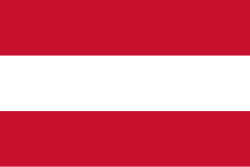
.JPG)


 KSF
KSF